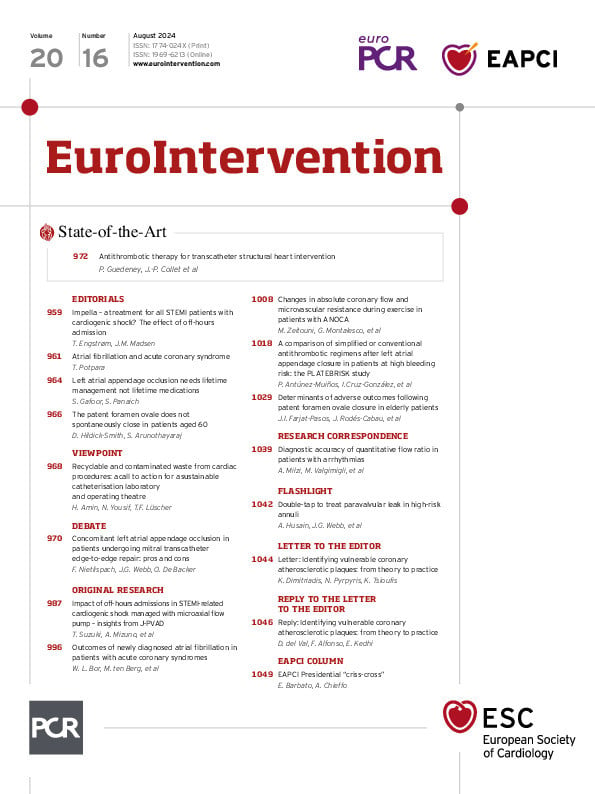Cory:
Unlock Your AI Assistant Now!
Post-dilatation (PD) can reduce paravalvular leak (PVL) and improve expansion after transcatheter aortic valve implantation (TAVI) with balloon-expandable valves1, but it can be associated with increased procedural complications, including a higher risk for early stroke and annular injury2. In general, PD is performed with extra volume added to the delivery system balloon or with a non-compliant balloon. The efficacy of PD performed using the same delivery system balloon at the same volume, also referred to as “double-tap”, remains unknown. Here, we highlight a case of successful treatment of PVL using the double-tap technique in the setting of a high-risk annulus.
A 77-year-old female presented with symptomatic severe aortic stenosis. Preprocedural computed tomography showed a type 1 bicuspid valve with moderate to severe raphe calcification and no aortic dilatation.
Surgical risk was high because of the patient’s comorbidities. It was decided to proceed with transfemoral TAVI using a 20 mm SAPIEN 3 Ultra valve (Edwards Lifesciences) at nominal volume with a predicted 2% area oversizing (annular area 324 mm2). A substantial displacement of leaflet calcium was visible during transcatheter heart valve (THV) expansion. Aortography after THV implantation revealed moderate PVL likely related to asymmetric underexpansion at the mid-portion of the THV. To minimise the risk of annular injury, PD using the double-tap technique with the same delivery system balloon was performed, resulting in a notable improvement of THV expansion and resolution of PVL (Moving image 1, Figure 1). Postprocedural echocardiography confirmed the absence of PVL and an estimated mean transaortic gradient of 14 mmHg.
This case illustrates the potential benefit of the double-tap technique in improving THV expansion and reducing PVL while limiting the number of technical steps as well as the need for a dedicated PD balloon. This strategy is of particular interest in patients with adverse root features, since the improvement in expansion is observed without adding volume to the balloon, focusing pressure on the underexpanded waist of the balloon while reducing overexpansion of the balloon shoulders. Larger studies with comparative analysis and long-term follow-up are needed to validate the safety and efficacy of the double-tap technique in improving THV expansion and to potentially explore its effect on THV haemodynamics.

Figure 1. Post-dilatation at nominal volume (double-tap technique) in a high-risk annulus. A) Pre-TAVI CT showing annular measurements (1); short-axis view with R-N raphe calcification (arrows; 2); long-axis commissural view with severe calcification (3). B) THV expansion before and after the double-tap technique. CT: computed tomography; N: non-coronary leaflet; R: right coronary leaflet; TAVI: transcatheter aortic valve implantation; THV: transcatheter heart valve
Conflict of interest statement
D.A. Wood is a consultant for and has received research funding from Edwards Lifesciences and Abbott. J.G. Webb is a consultant for Edwards Lifesciences; and receives research funding from Edwards Lifesciences, Medtronic, and Boston Scientific. J.A. Leipsic is supported by a Canadian Research Chair in Advanced Cardiopulmonary Imaging; consults for MVRx, HeartFlow Inc., and Circle Cardiovascular Imaging; and provides CT core lab services for Edwards Lifesciences, Medtronic, Neovasc, Boston Scientific, and Tendyne Holdings (owned by Abbott), for which no direct compensation is received. J. Sathananthan is an employee for Boston Scientific; has received speaker fees from Edwards Lifesciences; and is a consultant for Edwards Lifesciences, Boston Scientific, NVT Medical, and Medtronic. S.L. Sellers is a consultant for Edwards Lifesciences, Anteris, Excision Medical, and Medtronic. J. Sathananthan and S.L. Sellers have received research support from Medtronic, ViVitro Labs, and Edwards Lifesciences. M. Akodad is a consultant for Medtronic and Edwards Lifesciences. The other authors have no relevant conflicts of interest to declare.
Supplementary data
To read the full content of this article, please download the PDF.

